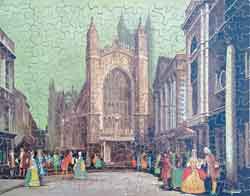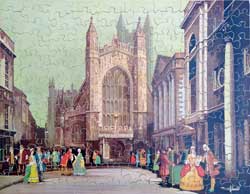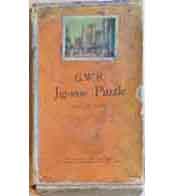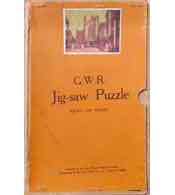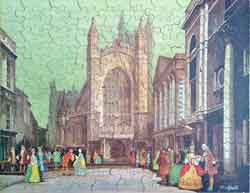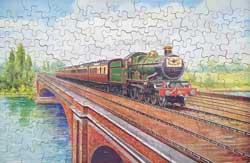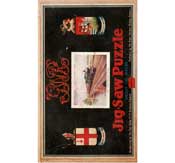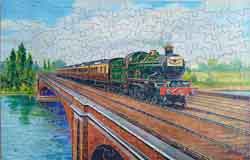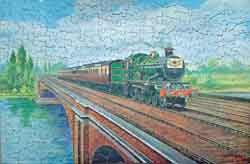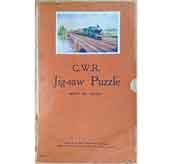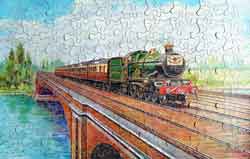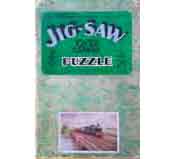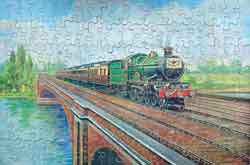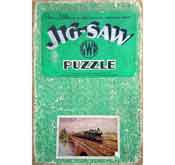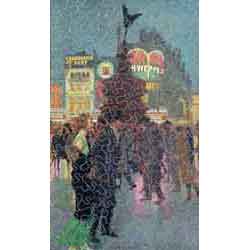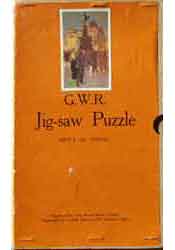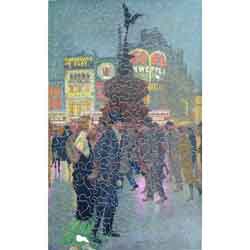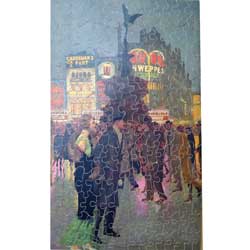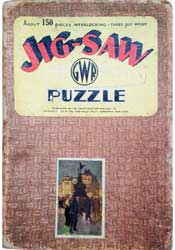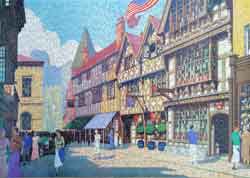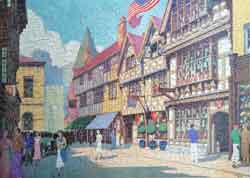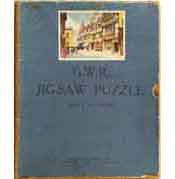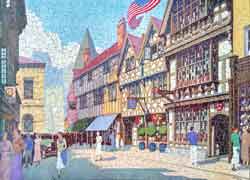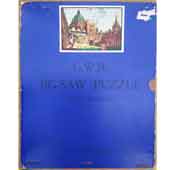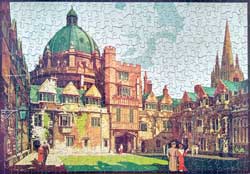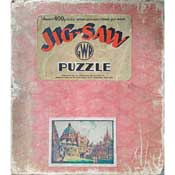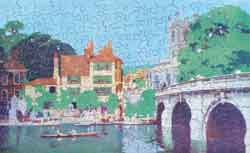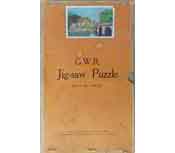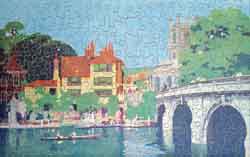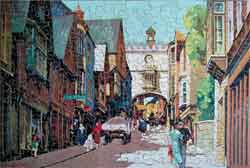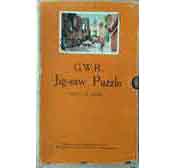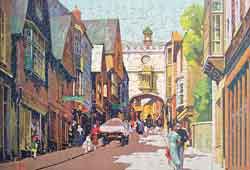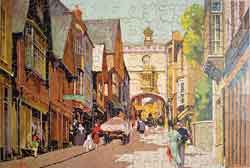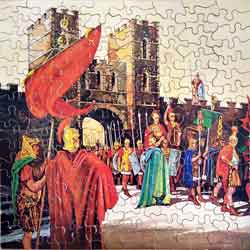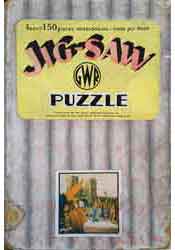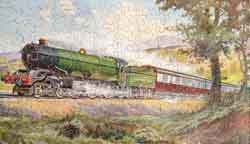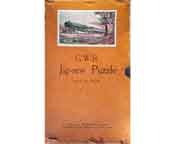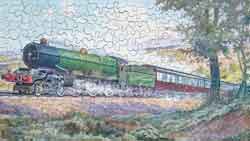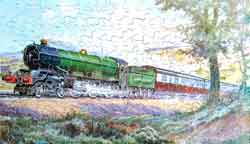GWR jigsaws
1932-1933 puzzles
Bath/Beau Nash's Bath 1932 until 1936
Painted by the artist Claude H.Buckle. This image was used on a poster advertising BATH in the 'This England of Ours' series printed for the GWR by Waterlow and Sons Ltd. which proclaimed BATH Famous Through The Centuries. The picture depicts the street leading to Bath Abbey around 1750 and illustrates the costume of that time. Two sedan chairs can be seen in the right foreground. This puzzle was first published with about 150 pieces in the earlier brown box with black label, but this was soon changed to the new slip case box. The example in our collection has a leaflet promoting Bath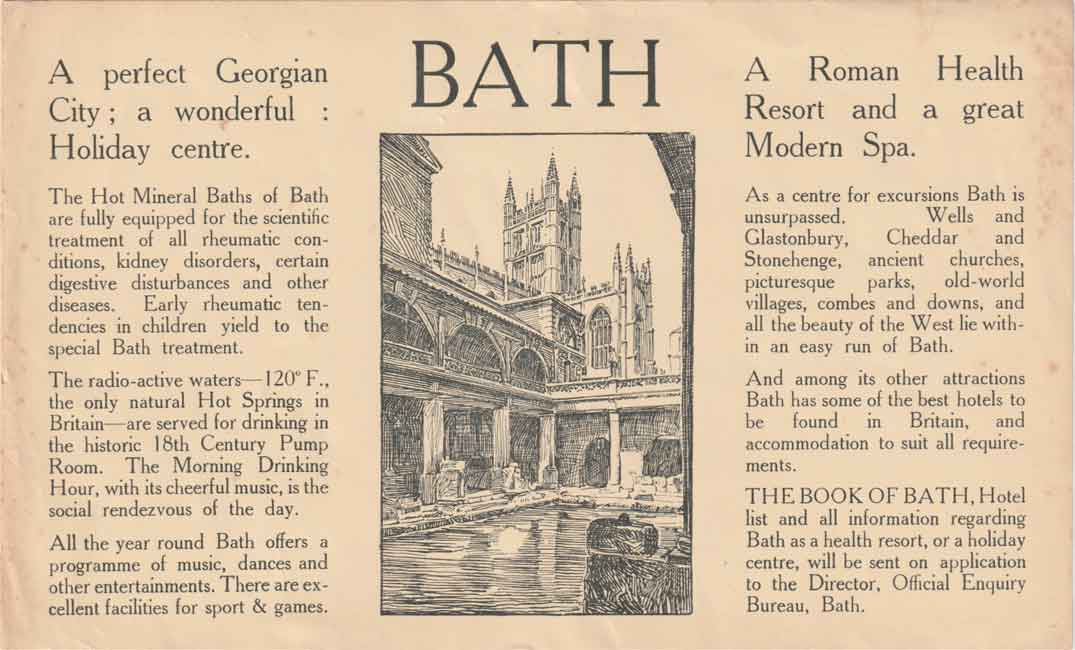
Click or tap link for a larger image glued to the inside of the lid. The puzzle was increased to about 200 pieces in 1934.
This title seems to have had something of an identity crisis as both sizes of puzzle were also produced with the name Beau Nash's Bath. Of the five versions of this puzzle in our collection, our later example of the 150 piece jigsaw in the orange slip case box is the only one to carry a guide picture with a title. Curiously, this title is Bath and not the title on the spine. This version also contains a loose copy of the leaflet promoting Bath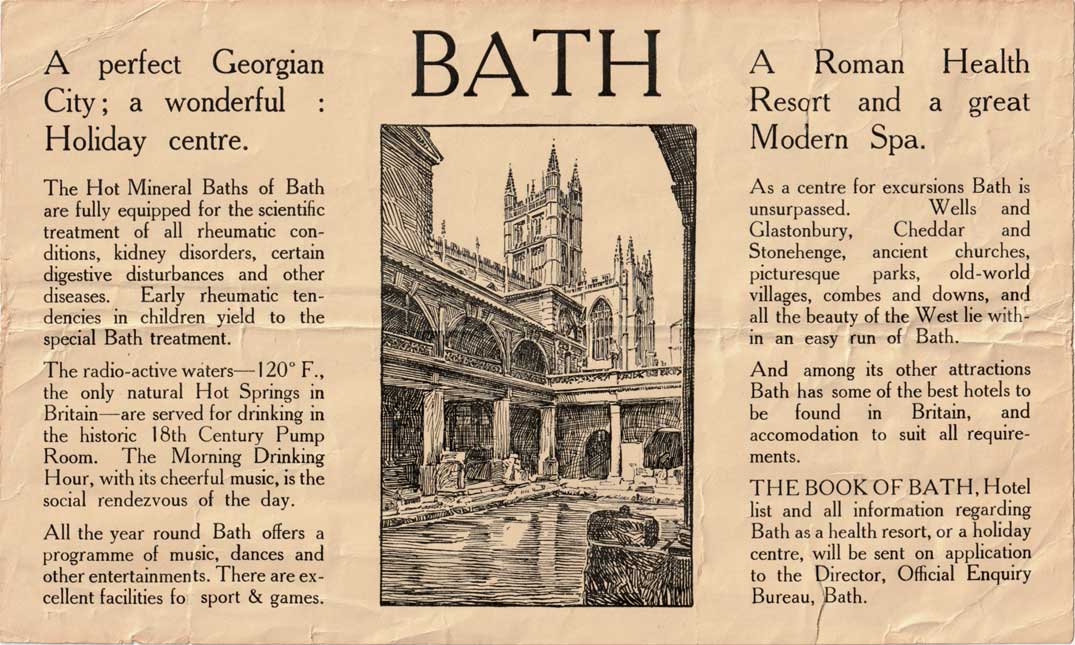
Click or tap link for a larger image and the original pamphlet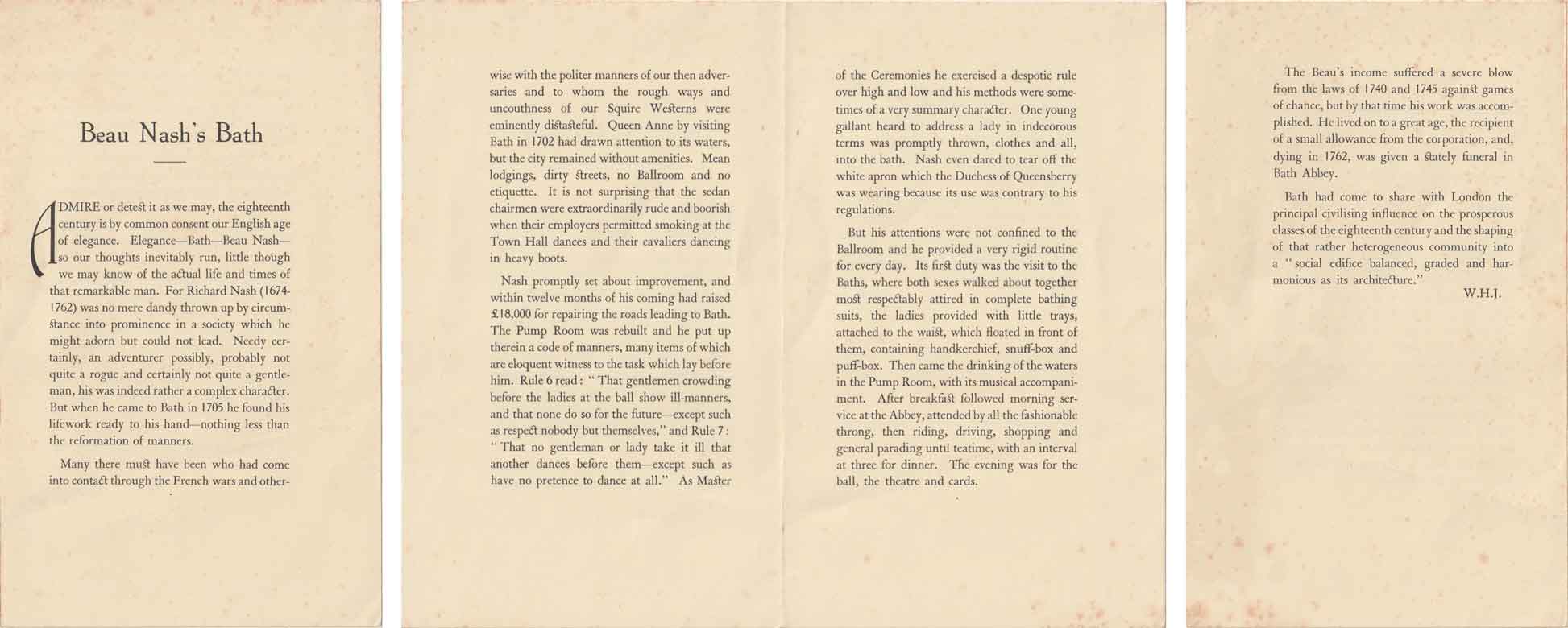
Click or tap link for a larger image written by W.H.J. with the title of Beau Nash's Bath. Included with the puzzle in the pink marbled book type box are the original pamphlet
Click or tap link for a larger image written by W.H.J.
and two leafletsClick or tap to see a gallery of these two leaflets
, one promoting rail travel from Paddington to Bath and the other being the leaflet promoting Bath itself.
The Cheltenham Flyer 1932 until 1937/1938
The painting is signed F.Moore, which was in fact a trade nameClick or tap to reveal our hidden page and find out more and not the name of an actual artist. Illustrated is engine number 5000 'Launceston Castle' crossing Maidenhead Bridge. This puzzle was first released with about 150 pieces before being increased to about 200 pieces in 1934. It was first seen advertised in the late 1932 edition of Literature of Locomotion, but some reference sources say that it was published in early 1933.
A full size copy of this image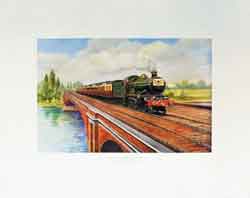
Printed by The Chad Valley Co. Ltd., Harborne and dated 1934
Approx 24½” x 19¼” overall
Author's collection printed on heavy art paper with a wide border ready for framing was sold by the GWR for 1/- (one shilling). It was first advertised in the late 1932 edition of Literature of Locomotion, and appeared in every subsequent one. Our print is dated 1934 but we have seen other undated examples. Interestingly, a heavily cropped version of this picture was also used by Chad Valley on several of their train set accessory boxesClick or tap to see two of the boxes.
The 150 piece example in the black label box contains both the original pamphlet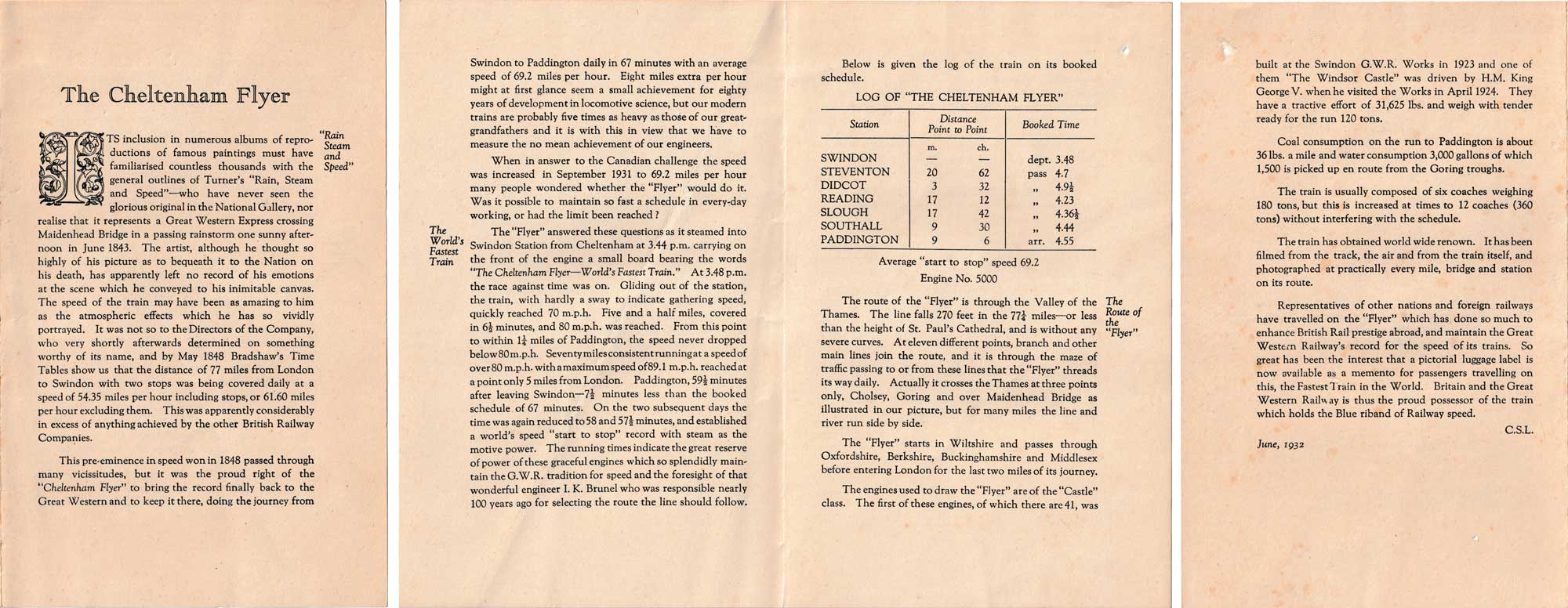
Click or tap link for a larger image written by C.S.Lock and dated June 1932 which gives the history and statistics for the train, and the original packing slip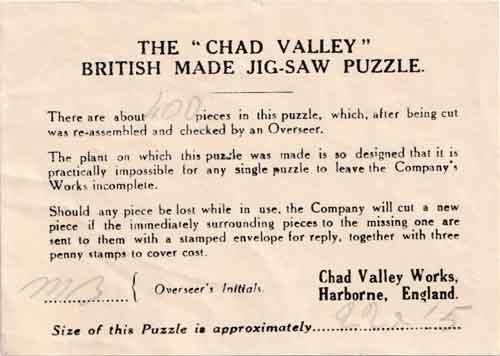
Click or tap link for a larger image. Our later 200 piece example in the green book type box contains the revised pamphlet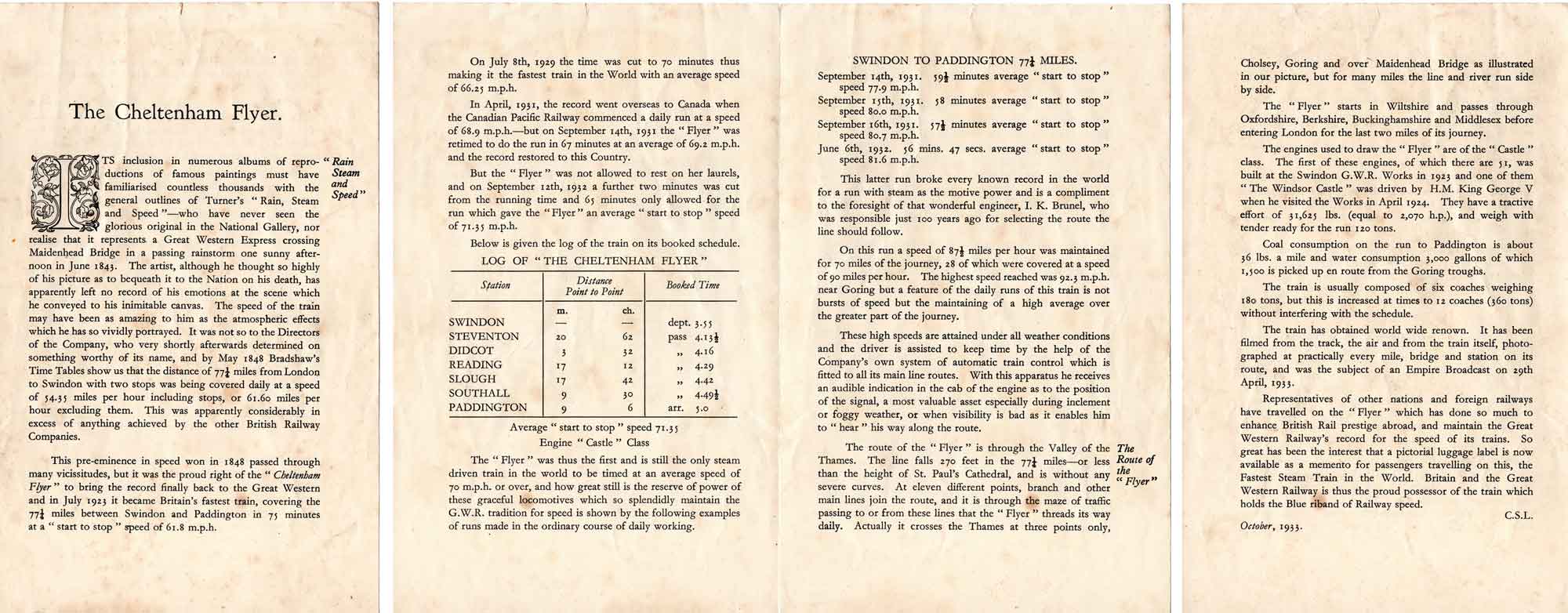
Click or tap link for a larger image giving the history and statistics for the train, again written by C.S.Lock but now dated October 1933. It is slightly puzzling as we have found the 150 piece and 200 piece versions both in the early slip case box and the 1934 book type box. Some reference works record this puzzle as being withdrawn in 1937 as a 200 piece puzzle, however, we found this 150 piece example with a label bearing the later GWR roundel. We guess that this puzzle was reduced in size to 150 pieces in 1938 but withdrawn from sale shortly after, never being advertised at the newly reduced size.
Piccadilly Circus 1933 until 1938
An unusual night scene with Eros in silhouette painted by the artist Charles Pears in 1932.
The famous illuminated advertisements can be seen in the background with three London buses passing behind the statue of Eros. The formal evening dress worn by the couple in the foreground and the style of hats worn by those further back are very much of their time. It was used on a poster advertising LONDON with the message Enquire for G.W.R. cheap ticket facilities. The puzzle retains the tall portrait format of the original artwork.
Some reference works record this puzzle as being withdrawn in 1937 and only ever being published with about 200 pieces, however, we found this example with a label declaring it to contain about 150 pieces. We guess that this puzzle was reduced in size to 150 pieces in 1938 but withdrawn from sale shortly after, never being advertised at the newly reduced size. Our example actually contains 175 pieces which suggests the cutter was still adjusting to the new size.
A limited number of prints of the poster were produced for sale by the GWR. They cost 2/6 (two shillings and six pence, or half a crown) each, and a pre‑printed order slip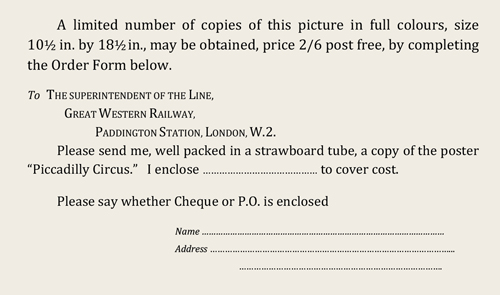
Reproduction print order slip
Click or tap link for a larger image would have been included with the jigsaw whilst stocks lasted.
Stratford‑upon‑Avon (Harvard House) 1933-1938
This puzzle is based on a painting by Michael Reilly which was also used on a poster in the 'This England of Ours' series being simply titled STRATFORD-UPON-AVON. First published with about 375 pieces, the puzzle was increased to about 400 pieces in 1934 and is known to have been later sold by Chad Valley under their own brand as an untitled 500 piece puzzle in a traditional lift-off lid type box with wrap around guide picture.
Prominent in the foreground is Harvard House of the title. It was the home of the maternal grandparents of John Harvard, founder of Harvard University. The house was built in 1596 for Thomas Rodgers and his wife Alice. Their daughter married Robert Harvard whose son, John, went to America in 1637. Possibly designed to appeal to a transatlantic audience, it is shown flying the American flag. First pubished with about 375 pieces, this was increased to about 400 pieces in 1934.
Both our examples of the 400 piece puzzle contain a copy of the original pamphlet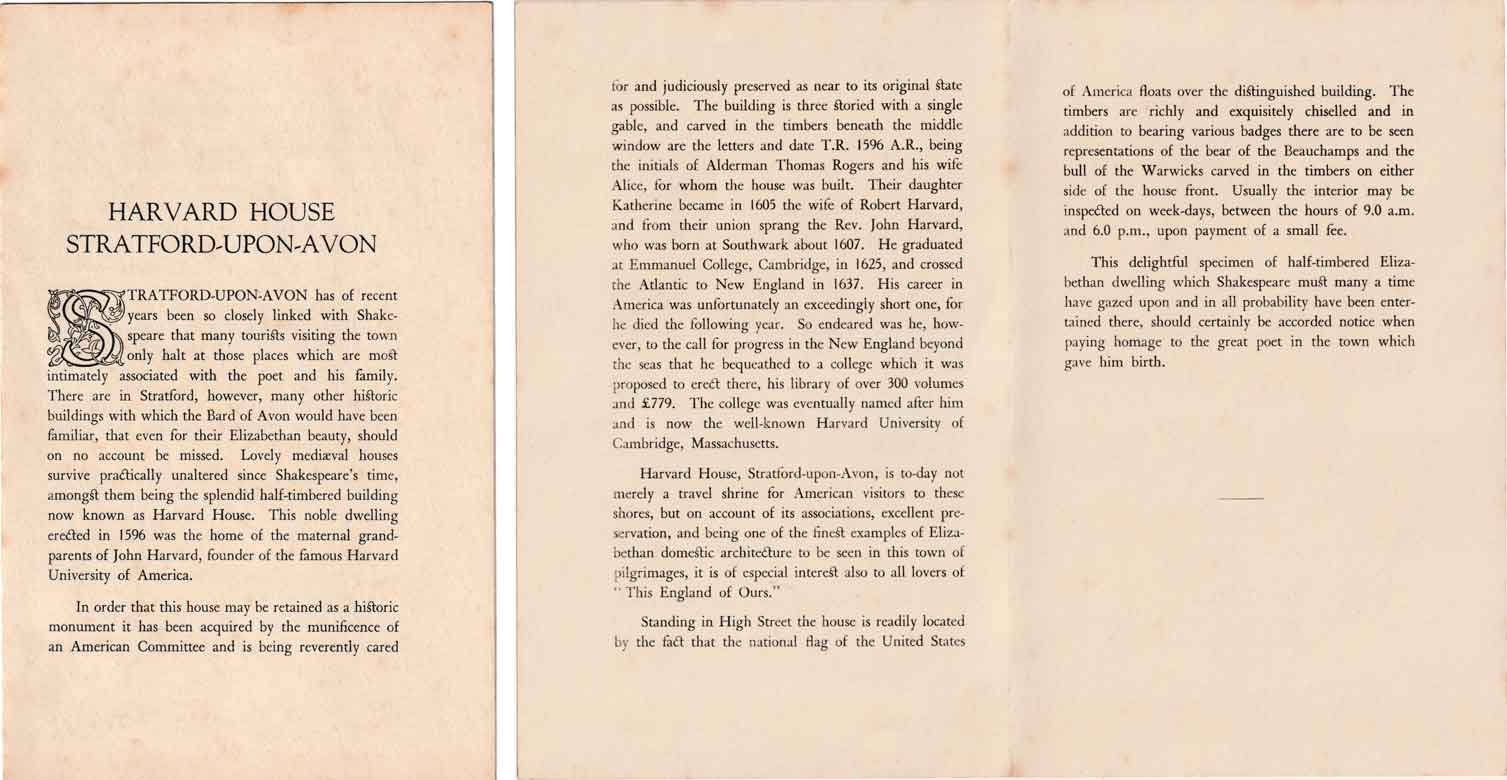
Click or tap link for a larger image which describes the history of Harvard House in Stratford-upon-Avon. Also included in the later example is the original packing slip
Click or tap link for a larger image.
Brazenose College, Oxford 1933 until 1939
Based on a painting of the view inside Brasenose College quad in Oxford by the artist Claude H.Buckle which is dated 1932. Although correctly appearing in advertisements as Brasenose College, we have only come across examples of this puzzle bearing the title Brazenose College, being wrongly spelt with a 'z' rather than an 's'. This is the only puzzle in the series to have a black border and was used for a poster advertising OXFORD in the 'This England of Ours' series.
Included with both our examples is a copy of the original pamphlet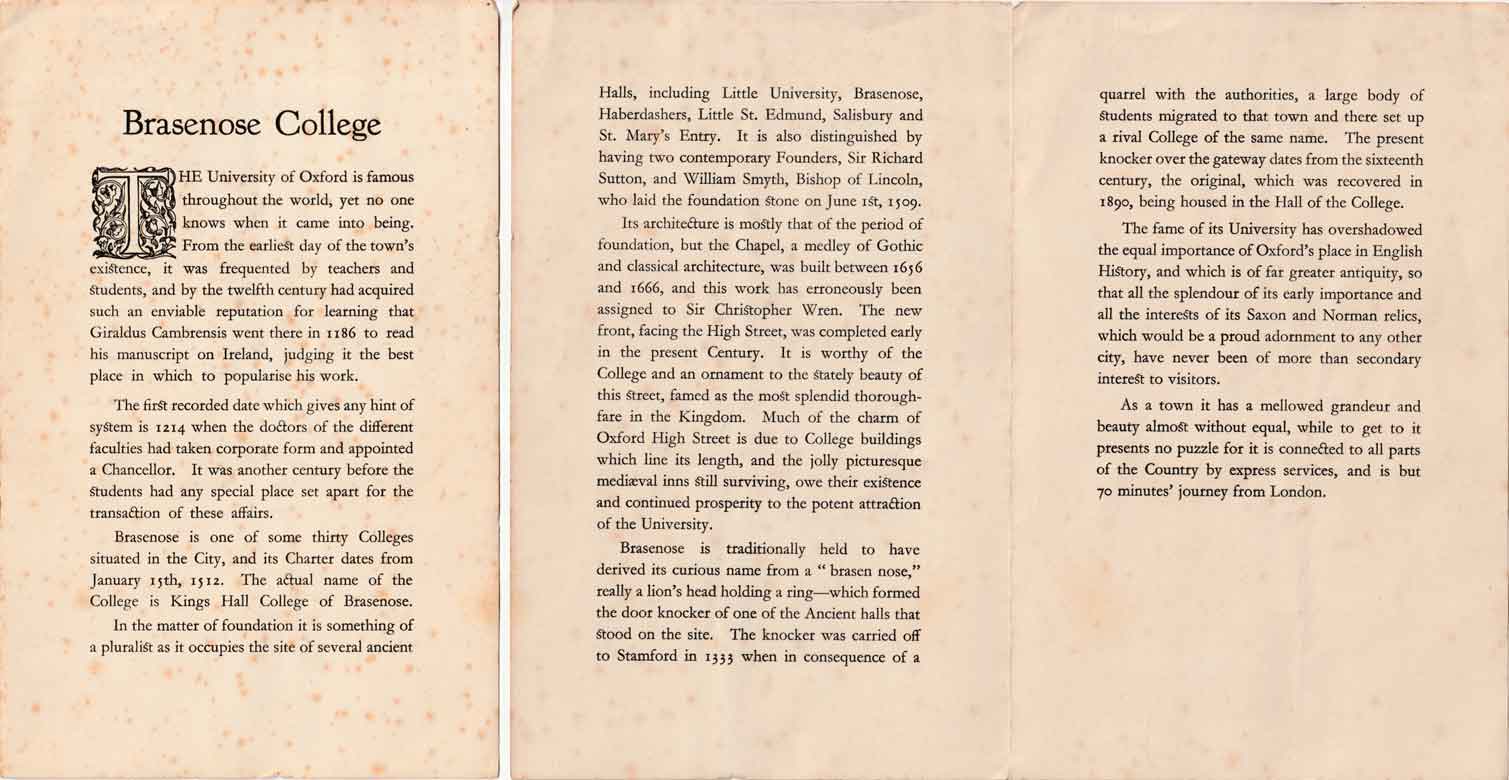
Click or tap link for a larger image which describes the history of Brasenose College in Oxford. A limited number of copies of the poster were made available for sale by the GWR costing 5/- (five shillings) each, and at 48" x 33" were quite large. Our later example still contains the original pre‑printed order slip
Click or tap link for a larger image in the box.
Henley Bridge 1933-1939
Painted in about 1925 by Fred Taylor, this image was used on a poster titled HENLEY BRIDGE which promoted a booklet which was published in March 1928, being an Illustrated Travel Book "The Appeal of the Thames"
Author's collection obtainable free at G.W.R. Stations and Offices.
The picture shows the 'Angel' and St. Mary's Church from across the river with the bridge on the right. Close examination reveals a gentleman sitting astride the bridge parapet with one leg dangling over the water - a rather unsafe position. The riverside appears to be quite busy and there are several rowing boats on the water. The puzzle was first released with about 200 pieces, but was reduced to about 150 pieces in 1938.
The label on the front of our example of the 200 piece version in the book type box bears the early ornate GWR initials, whereas the later GWR roundel appears on the spine label. This suggests that it may well have been produced during 1934 when labels were being changed, with old stock being used up on the box fronts and the latest labels starting to be used on the spine.
Historic Totnes 1933 until 1939
View up Fore Street and High Street featuring East Gate, by the artist Claude H.Buckle. This image was used on a poster in the 'This England of Ours' series titled Historic Totnes - Devon.
First published with about 200 pieces, the puzzle was reduced to about 150 pieces in 1938. Known to have been later sold by Chad Valley under their own brand as an untitled 175 piece puzzle in a traditional lift-off lid type box with wrap around guide picture.
The Romans at Caerleon 1933 until 1939
Painted by the artist Claude H.Buckle showing Roman soldiers entering the gate at Caerleon Castle which is near Newport.
This puzzle was first released with about 200 pieces, but was reduced to about 150 pieces in 1938. The painting was used on a rather wordy poster titled Roman Britain CAERLEON [Mon.]. It read A wonderful amphitheatre has recently been excavated and may now be seen at CAERLEON, the famous city of the Roman Legionaries. Founded in A.D.75. A visit will open a page of history of over 17 centuries ago. Book to: CAERLEON STATION Monmouthshire.
Included with the reboxed version of the 200 piece puzzle is a copy of the booklet 'The Literature of Locomotion' dated November 1934, the original packing slip
Click or tap link for a larger image, the original pamphlet
Click or tap link for a larger image describing the history of Caerleon, and a folded 'Map of G.W.R. system’. This is therefore a rare survivor of a puzzle as it might have been bought new sometime before 1938. The label on the front of this particular example bears the early ornate GWR initials, whereas the later GWR roundel appears on the spine label. This suggests that it may well have been produced during 1934 when labels were being changed, with old stock being used up on the box fronts and the latest labels starting to be used on the spine.
Royal Route to the West 1933 until 1939
King George V with its famous bell heading the Cornish Riviera Express, painted by George H.Davis in 1929. The train is seen near South Brent with Dartmoor in the background. This puzzle was first published with about 200 pieces and was reduced to about 150 pieces in 1938. The picture also bears the note Reproduced by permission of the "Illustrated London News" towards the bottom left. It is believed that prints of this picture were available to buy.
The label on the front of the first example of the 200 piece version in the green book type box bears the early ornate GWR initials, whereas the later GWR roundel appears on the spine label. This suggests that it may well have been produced during 1934 when labels were being changed, with old stock being used up on the box fronts and the latest labels starting to be used on the spine.
Included in the box for the last of the 200 piece versions is the original packing slip
Click or tap link for a larger image, and a copy of the booklet 'The Literature of Locomotion' which is dated November 1934.


